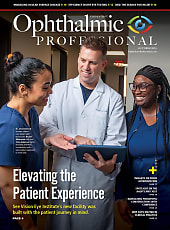
A 65-year-old male was referred for a retina consultation due to sudden painless vision loss in his right eye. The patient reported a history of hypertension and hyperlipidemia. He had recently been treated with cardiac stents due to non-ST elevated myocardial infarction. The patient denied a prior ocular history.
On examination, the visual acuity in the right eye was reduced to 20/100 without correction, while the left eye had a visual acuity of 20/25 without correction. Fundus examination and optomap color rgb ultra-widefield (UWF™) imaging revealed segmental retinal whitening in the macula. Optical coherence tomography demonstrated paracentral acute middle maculopathy. Optos UWF fluorescein angiography (optomap fa) confirmed prolonged transit with early patchy choroidal filling and areas of abnormal retinal perfusion affecting the periphery, with some residual perfusion visible in other segments could be observed, which further corroborated the color image findings. In the optomap color rgb UWF image, retinal whitening and red appearing fovea due to ganglion cell edema is highlighted with blue arrows.
DISCUSSION
Ocular ischemia is a vision-threatening condition that necessitates timely diagnosis and multidisciplinary management. It occurs as an ocular manifestation of vascular disease, often indicating carotid artery pathology. The prognosis for patients with ocular ischemia depends largely on the severity of carotid artery disease and the time until intervention.
In this patient, the predisposing factors were hypertension, hyperlipidemia and history of myocardial infarction.
optomap color rgb UWF imaging supported in the discovery of associated findings and is a useful tool for detecting characteristics of central, midperipheral and peripheral retinal lesions. Prompt identification with Optos multimodal imaging and systemic risk factor management are crucial to preventing further vascular events. The patient will require continued monitoring and collaboration with their primary care physician and vascular surgeons to address underlying cardiovascular risks.1,2
References
1. Suhail S et al. Ocular ischemic syndrome and the role of carotid artery revascularization. Ann Vasc Surg. 2024; 105: 165–176. doi: 10.1016/j.avsg.2023.12.098
2. Vilares-Morgado R, Nunes HMM, Dos Reis RS, Barbosa-Breda J. Management of ocular arterial ischemic diseases: A review. Graefes Arch Clin Exp Ophthalmol. 2023; 261: 1–22 (2023). doi: 10.1007/s00417-022-05747-x
------------------
William Freeman, MD, is distinguished professor of ophthalmology and electrical engineering, vice chairman of the department of ophthalmology and director of the Jacobs Retina Center at the University of California at San Diego. He has an interest in retinal imaging as well as artificial intelligence and drug delivery and is NIH-funded to pursue these two areas of research. Dr. Freeman has trained more than 100 VitreoRetinal fellows and published more than 700 peer reviewed papers, and he is actively engaged with efforts to improve retinal imaging, analyze images from multiple devices and improve treatments for patients with retinal disease.

Ines Nagel, MD, is a retina research fellow under the supervision of Dr. William Freeman at the Jacobs Retina Center at the University of California San Diego. Her interests lie in retinal imaging, with a focus on age-related macular degeneration, diabetic retinopathy and inherited retinal diseases. Dr. Nagel is involved in clinical research pertaining to these conditions and aims to advance the understanding and treatment options in the field of retinal health.
----------------
Submit your interesting UWF optomap cases here:
https://optos.is/StoriesInOphthalmology
----------------
This content is sponsored by









